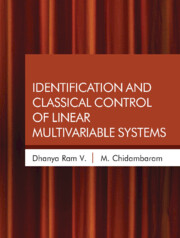Book contents
- Frontmatter
- Contents
- Preface
- Acknowledgements
- List of Abbreviations
- Notations
- 1 Models, Control Theory, and Examples
- 2 Identification and Control of SISO Systems
- 3 Introduction to Linear Multivariable Systems
- 4 CRC Method for Identifying TITO Systems
- 5 CRC Method for Identifying SISO Systems by CSOPTD Models
- 6 CRC Method for Identifying TITO Systems by CSOPTD Models
- 7 Identification of StableMIMO System by Optimization Method
- 8 Identification of Centralized ControlledMultivariable Systems
- 9 Identification of Multivariable SOPTD Models by Optimization Method
- 10 Identification of Unstable TITO Systems by Optimization Technique
- 11 Centralized PI Controllers Based on Steady State Gain Matrix
- 12 SSGM Identification and Control of Unstable Multivariable Systems
- 13 Control of Stable Non-square MIMO Systems
- 14 Control of Unstable Non-square Systems
- 15 Trends in Control ofMultivariable Systems
- Appendix A Identification of Unstable Second Order Transfer Function Model with a Zero by Optimization Method
- Appendix B For Chapter 3
- Appendix C For Chapter 7
- Bibliography
- Index
5 - CRC Method for Identifying SISO Systems by CSOPTD Models
Published online by Cambridge University Press: 31 July 2022
- Frontmatter
- Contents
- Preface
- Acknowledgements
- List of Abbreviations
- Notations
- 1 Models, Control Theory, and Examples
- 2 Identification and Control of SISO Systems
- 3 Introduction to Linear Multivariable Systems
- 4 CRC Method for Identifying TITO Systems
- 5 CRC Method for Identifying SISO Systems by CSOPTD Models
- 6 CRC Method for Identifying TITO Systems by CSOPTD Models
- 7 Identification of StableMIMO System by Optimization Method
- 8 Identification of Centralized ControlledMultivariable Systems
- 9 Identification of Multivariable SOPTD Models by Optimization Method
- 10 Identification of Unstable TITO Systems by Optimization Technique
- 11 Centralized PI Controllers Based on Steady State Gain Matrix
- 12 SSGM Identification and Control of Unstable Multivariable Systems
- 13 Control of Stable Non-square MIMO Systems
- 14 Control of Unstable Non-square Systems
- 15 Trends in Control ofMultivariable Systems
- Appendix A Identification of Unstable Second Order Transfer Function Model with a Zero by Optimization Method
- Appendix B For Chapter 3
- Appendix C For Chapter 7
- Bibliography
- Index
Summary
In this chapter, a Closed Loop Reaction Curve (CRC) method is given for identifying analytically the Single Input Single Output (SISO) systems by Critically Damped Second Order Plus Time Delay (CSOPTD) process transfer function models from the closed loop step response. The material presented here will form the basis for the next chapter on identification of multivariable critically damped systems.
CSOPTD Systems
Introduction
The dynamics of many of the stable processes can be described by that of an over-damped second order system whereas that of the closed loop system is represented by a second order under-damped response. For the purpose of designing PID controllers, many processes are described by a stable second order critically damped transfer function model:
Since the critically damped SOPTD model has only three parameters, the identificationmay be easier than the four parameters required for the over-damped SOPTD models. The time delay is due to the measurement delay or the actuator delay and/or due to approximation of higher order systems by a simple SOPTD model. In this chapter, the method to identify a SOPTD model with equal time constants is discussed. A simple method of calculating the process steady state gain is applied.
Identification of Critically Damped SOPTD and FOPTD Systems
For the purpose of designing controllers, the process is assumed as given in Eq. (5.1). The form of equation in Eq. (5.2) for PID controller is used.
Where,
The closed loop transfer function model is derived as in Eq. (5.4).
For a given step change in the set point, the closed loop response is obtained as shown in Fig. 5.1. Chidambaram and Padmasree (2006) used the u versus time and y versus time profile to get the steady state gain of the system. Since an integral action is present in the controller, the output will reach the desired steady state and hence the input variable of the process will also reach a steady state. The ratio of change in y (output variable deviation) and change in u (manipulated variable deviation) at the steady state gives the steady state gain (kp).
- Type
- Chapter
- Information
- Publisher: Cambridge University PressPrint publication year: 2023

